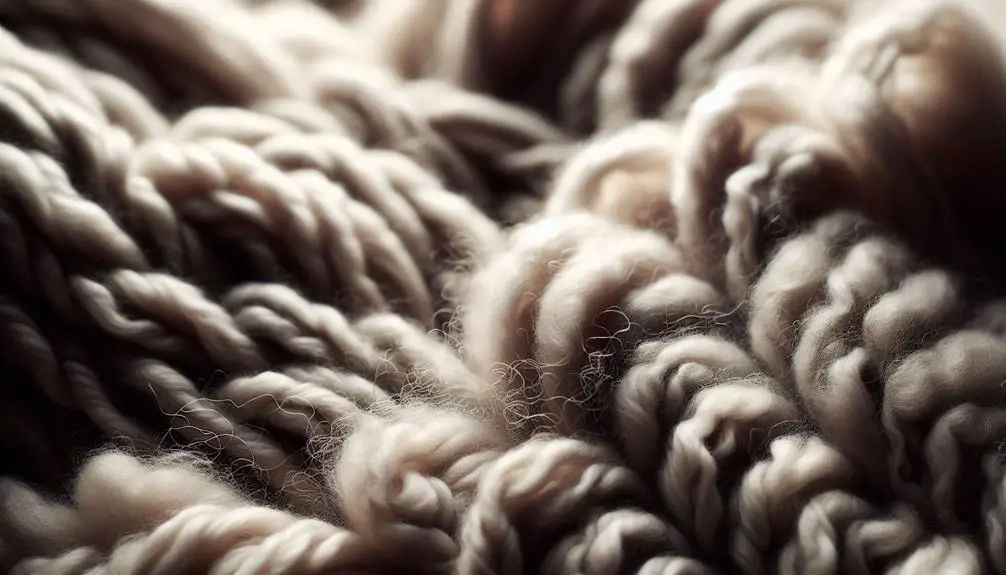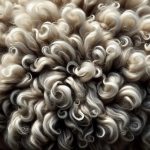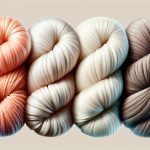If you want a material that looks like wool, consider cashmere, merino, mohair, alpaca, or camel. These offer a luxurious feel similar to wool but with unique qualities. Each material brings its own touch of softness and warmth. If you explore these options, you might discover the perfect match for your needs.
Table of Contents
Key Takeaways
- Acrylic: Synthetic material resembling wool
- Polyester: Similar appearance to wool
- Fleece: Soft, wool-like texture
- Chenille: Soft, fuzzy fabric like wool
- Bouclé: Textured yarn for wool-like look
Cashmere
Cashmere, sourced from Cashmere goats, stands out for its unparalleled softness and exceptional warmth. These goats, also known as Angora goats, produce this luxury fiber with fibers finer than human hair. The process of obtaining Cashmere wool is labor-intensive, which contributes to its high cost and limited production. This exclusivity adds to the allure of Cashmere, making it a highly sought-after material in the fashion and textile industries.
The luxurious feel and insulating properties of Cashmere wool make it a popular choice for high-end products. Its fine fibers create a fabric that isn't only soft to the touch but also incredibly warm, perfect for winter garments and accessories. Cashmere wool comes in various grades and blends, providing versatility in its applications. Whether used in pure form or blended with other fibers, Cashmere continues to be a symbol of sophistication and elegance in the world of fashion.
Merino
Merino wool is renowned for its exceptional softness and fineness, setting it apart as a top choice for various garments. Its breathability and moisture-wicking properties make it a favorite for activewear and base layers.
Blending with other fibers enhances its strength and durability, making Merino a sought-after material in high-end fashion and performance clothing.
Merino Characteristics
Renowned for its exceptional softness and breathability, Merino wool stands out as the softest and finest type of wool available.
Its natural moisture-wicking properties make it ideal for activewear and base layers, keeping you dry and comfortable during physical activities.
Additionally, Merino wool is naturally resistant to wrinkles, ensuring a neat appearance even after prolonged wear.
This wool is often blended with other fibers to enhance strength and durability in garments, making it a popular choice for various applications.
Whether you're hitting the gym or exploring the great outdoors, Merino wool's quality and performance set it apart as a superior material for those who appreciate luxury and functionality in their clothing.
Wool-Like Qualities
Moving from the exceptional softness and breathability of Merino wool, exploring its wool-like qualities reveals a versatile material that excels in various applications.
Merino wool, a fabric made from the fleece of Merino sheep, closely resembles traditional wool in appearance and texture. This material shares the insulating properties of wool, providing warmth without bulk, making it an excellent choice for winter clothing.
Additionally, Merino wool is renowned for its moisture-wicking abilities, keeping the wearer dry and comfortable in various climates. Its natural elasticity helps garments made from it retain their shape, reducing the need for frequent washing and ironing.
Mohair
Mohair boasts a remarkable softness that sets it apart from other fibers, making it a luxurious choice for textiles.
Its appearance is equally impressive, with a natural sheen that enhances the elegance of any fabric it creates.
The combination of softness and visual appeal makes Mohair a coveted material in the world of high-end textiles and upholstery.
Softness of Mohair
With its exceptional softness, Mohair stands out as a luxurious and comfortable fabric choice. The plush and silky texture of Mohair comes from its long and durable fibers, providing a delightful sensation against the skin.
This natural fiber not only feels incredibly soft but also offers a high sheen, adding an element of elegance and sophistication to any garment or textile it's used in. Originating in Tibet and primarily produced in South Africa, Mohair is considered a premium material often found in luxury textiles and upholstery due to its unmatched softness and durability.
Additionally, Mohair takes dye exceptionally well, allowing for a wide range of vibrant and rich color options while maintaining its lustrous appearance.
Appearance of Mohair
Coming from its exceptional softness, Mohair's appearance exudes a luxurious sheen and premium quality, making it a sought-after material for high-end garments and accessories.
Mohair, a fabric derived from the long, durable fibers of Angora goats, is renowned for its high luster and superior quality. The fabric's sheen adds a touch of elegance to any clothing or upholstery it adorns, making it a top choice for luxurious textiles.
Mohair's ability to absorb dyes exceptionally well results in vibrant, long-lasting colors that enhance its appeal further. Originating in Tibet, this prized material is mainly produced in South Africa, where the Angora goats thrive.
The exquisite appearance of Mohair makes it a top pick for those seeking sophistication and opulence in their wardrobe choices.
Alpaca
Known for its hypoallergenic properties and silky texture, Alpaca wool is a popular choice for those seeking a luxurious and sustainable alternative to traditional sheep's wool. Alpaca wool is a great option for individuals with wool sensitivities.
Here are some key points about Alpaca wool:
- Hypoallergenic: Alpaca wool is gentle on the skin, making it suitable for those who experience wool sensitivities.
- Silky Texture: Known for its softness, Alpaca wool feels luxurious against the skin.
- Water-Resistant: Alpaca wool naturally repels moisture, keeping you dry and comfortable.
- Durable: This wool type is strong and long-lasting, ensuring that your garments stand the test of time.
Alpaca wool, softer than sheep's wool, offers excellent thermal regulation, keeping you warm in the cold and cool in the heat. Additionally, it's sustainable and eco-friendly, making it a conscious choice for those who value both quality and environmental responsibility.
Camel
Obtained from two-humped camels, camel wool boasts lightweight and shiny qualities, making it a sought-after natural fiber for luxurious tailored coats. This unique wool is known for its durability and long-lasting nature, ideal for crafting garments that stand the test of time. Camel wool's water-resistant properties and excellent insulation make it a top choice for cold weather clothing, ensuring both style and functionality. Its natural shades and exceptional qualities have cemented its status in high-end fashion, where it's valued for its distinct characteristics.
Due to the limited availability of camel wool and the traditional processing methods involved, this exquisite material comes at a higher cost compared to other types of wool. The intricate craftsmanship required to obtain camel wool further adds to its exclusivity and premium appeal. For those seeking quality, luxury, and a touch of sophistication in their wardrobe, camel wool presents itself as a timeless and elegant choice.
Virgin Wool
I'll start by highlighting the characteristics, benefits, and care instructions for virgin wool.
Virgin wool stands out for its softness and premium quality, making it a top choice for high-end clothing.
To maintain its luxurious feel, it's important to follow professional dry cleaning recommendations.
Characteristics of Virgin Wool
Virgin wool, sourced from the first shearing of sheep, boasts unparalleled purity and quality due to its unprocessed nature.
- Virgin wool is known for its exceptional softness and fine texture, often used in high-end and luxury garments.
- This type of wool is free from impurities or recycled fibers, ensuring a pure and high-quality material.
- Virgin wool offers superior insulation properties and natural elasticity, providing both warmth and comfort.
- Durable, resilient, and excellent at retaining heat, virgin wool is ideal for a variety of high-quality clothing items.
Benefits of Virgin Wool
Boasting exceptional softness and fine texture, virgin wool stands out as a top choice for high-end and luxury garments. When considering knit fabric options, the benefits of virgin wool are truly remarkable. Let's explore some key advantages in the table below:
| Benefits of Virgin Wool | Description |
|---|---|
| Softness | Virgin wool is known for its exceptional softness, providing a luxurious feel against the skin. |
| Heat Retention | This wool retains heat effectively, making it perfect for creating warm and cozy garments like coats and sweaters. |
| Durability | With its resilience and elasticity, virgin wool is highly durable and maintains its shape well over time. |
| Luxury Appeal | Virgin wool's premium quality makes it a top choice for high-end fashion due to its luxurious properties. |
Virgin wool truly excels in providing comfort, warmth, and longevity, making it a preferred option for those seeking quality knitwear.
Care for Virgin Wool
Care for virgin wool is essential to preserve its natural properties and quality, requiring gentle cleaning methods to maintain its luxurious feel and warmth. When caring for this high-quality wool fabric, consider the following:
- Dry Clean Professionally: To avoid shrinkage or damage, opt for professional dry cleaning services.
- Avoid Water Washing: Refrain from washing virgin wool in water to prevent texture and appearance alterations.
- Use Gentle Cleaning Products: Harsh chemicals can affect the wool's quality, so opt for mild cleaning agents.
- Proper Storage: Store virgin wool in a cool, dry place to prevent moths and maintain its pristine condition.
Vicuña
Nestled in the Andes Mountains of South America, vicuña wool stands out as one of the rarest and most coveted materials globally for its exceptional softness and warmth. Sustainably sourced from vicuñas, this wool is lightweight, highly breathable, and hand-harvested every two years, making it a highly sought-after material for luxury clothing. The fibers of vicuña wool are incredibly fine, resulting in a luxurious feel and excellent insulating properties. Vicuñas, protected animals living in the Andes Mountains, add to the exclusivity and value of their wool.
| Features of Vicuña Wool | ||
|---|---|---|
| Exceptional Softness | Lightweight | Highly Breathable |
| Hand-harvested | Luxurious Feel | Excellent Insulation |
| Rare & Coveted | Sustainable Sourcing | Exclusivity |
In the world of luxury clothing, vicuña wool reigns supreme, offering unparalleled comfort and quality. Its scarcity and the meticulous process of obtaining it contribute to its high value and desirability among those seeking the finest materials available.
Wool Tweed
Wool tweed, a durable and moisture-resistant fabric, is renowned for its classic appearance and texture, commonly used in suits, jackets, and coats for a traditional and sophisticated look. This fabric features a modified twill weave with two or more colors, creating a broken zigzag pattern. Here are some key points about wool tweed:
- Wool tweed can be dry cleaned or hand washed carefully to maintain its quality and appearance.
- Popular varieties of wool tweed include Harris tweed, Donegal tweed, and Shetland tweed, each with unique characteristics and origins.
- The fabric's traditional appearance adds a touch of elegance to any garment it's used in.
- Wool tweed's moisture-resistant properties make it a practical choice for outerwear in varying weather conditions.
Wool Gauze
Lightweight and airy, wool gauze offers a delicate texture ideal for creating comfortable and breathable garments. This type of fabric, made from wool fibers, is known for its lightness and softness, resembling traditional gauze fabrics in its appearance and feel. Despite its lightweight nature, wool gauze provides excellent warmth, making it a versatile choice for various clothing items. The natural insulation properties of wool guarantee that garments made from wool gauze can keep you cozy without feeling heavy or bulky.
Designers often choose wool gauze for creating pieces that require both breathability and warmth. Its ability to regulate body temperature makes it an excellent option for clothing suitable for different weather conditions. Whether used in layering pieces or standalone garments, wool gauze adds a touch of luxury and comfort to any wardrobe. Its fine texture and quality construction make it a favored choice for those seeking lightweight wool fabrics that prioritize both style and functionality.
Wool Voile
With a soft, smooth texture and a subtle sheen, wool voile presents a luxurious option for creating elegant and comfortable clothing pieces. Wool voile is a lightweight fabric that resembles traditional wool but is made from wool blends or other fibers. Here are some key points about wool voile:
- Wool voile drapes beautifully and has a luxurious feel, making it ideal for creating flowing dresses.
- This fabric is often used for lightweight garments like blouses, providing the aesthetic appeal of wool without the heaviness.
- Wool voile's soft texture adds a touch of elegance to scarves, enhancing their overall look and feel.
- Due to its lightweight nature, wool voile is a versatile choice for various clothing projects, offering both style and comfort in one fabric.
Wool Challis
Known for its versatility and excellent draping qualities, Wool Challis is a lightweight fabric that offers a wide range of design possibilities in both casual and formal wear. Wool Challis is a fabric made from woolen yarns, giving it a smooth and soft texture akin to wool. It is popularly used in creating garments like dresses, skirts, and blouses due to its flowing drape and comfortable feel. This fabric's ability to drape elegantly makes it ideal for creating flowing and graceful silhouettes. Wool Challis comes in various colors and prints, allowing for endless design options.
| Properties | Description | Benefits |
|---|---|---|
| Weight | Lightweight | Easy to wear |
| Texture | Smooth and soft | Comfortable feel |
| Draping Quality | Excellent draping qualities | Creates flowing garments |
| Versatility | Can be used for casual and formal wear | Wide range of design options |
| Color Options | Available in a variety of colors and prints | Versatile in design choices |
Wool Crepe
Crafted from wool fibers or wool blends, Wool Crepe is a luxurious fabric known for its distinctive crepe texture and elegant appearance. This fabric closely resembles traditional wool, offering a wool-like feel that exudes sophistication. Here are some key points about Wool Crepe:
- Distinctive Texture: Wool crepe stands out due to its unique crepe texture, giving garments a rich and textured look.
- Excellent Drape: Known for its exceptional draping qualities, wool crepe flows gracefully and enhances the silhouette of various clothing pieces.
- Luxurious Look: With a luxurious appearance and feel, wool crepe is a popular choice for high-end fashion items like dresses, skirts, and suits.
- Versatile Usage: This fabric is versatile and can be used for both formal and casual wear, providing a wool-like aesthetic without the bulkiness of traditional wool fabrics.
Wool crepe is a versatile and elegant material that adds a touch of luxury to any wardrobe, making it a favorite among designers for creating timeless and sophisticated pieces.
Frequently Asked Questions
What Fabric Looks Like Wool?
Cotton laine fabric from the Cotton Works Wovens collection by Polly Minick & Laurie Simpson resembles wool in appearance and thickness. It has a brushed quality and requires adjustments when sewing. Prepping with sizing, using a larger seam allowance, and pressing seams open are recommended.
What Is Similar to Wool?
Similar to wool, cotton laine fabric from the Cotton Works Wovens collection by Polly Minick & Laurie Simpson offers a wool-like appearance and thickness. It requires special sewing adjustments due to its unique characteristics.
What Is a Fiber That Looks Like Wool?
I find cotton laine fabric to be a great fiber that looks like wool. It blends cotton with a wool appearance, giving it a cozy feel. It's woven with slightly thicker threads, providing that classic woolen texture.
What Material Is Used to Simulate Wool?
To simulate wool, I recommend using a fabric like Cotton Works Wovens Cotton Laine. It's a cotton material with a wool-like appearance, achieved through its thickness and brushed texture. Adjust sewing techniques accordingly and prep with sizing for best results.
- How Does Ring Spun Cotton Affect Garment Fit and Shape Retention? - August 13, 2024
- What Are the Challenges in Producing Ring Spun Cotton? - August 13, 2024
- Is Ring Spun Cotton Suitable for Plus-Size Clothing? - August 13, 2024





